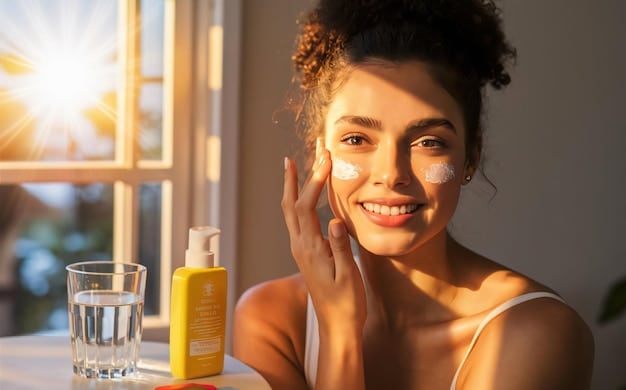Daily Sunscreen: Essential for Anti-Aging Skincare

Advertisements
Daily Sunscreen isn’t just a summer accessory; it’s the quiet hero of youthful skin. Every time you step outside, invisible rays work against you, and only consistent protection can slow their effects.
While cleansers and serums bring instant gratification, they can’t shield you from the deeper damage caused by UV exposure. That role belongs to sun care, the step that truly determines how your skin will look years from now.
Advertisements
Making this habit part of your morning ritual means more than avoiding burns. It’s about preserving firmness, radiance, and long-term skin health, an investment in your future reflection.
The Unseen Enemy: Understanding UV Radiation and Its Impact
Ultraviolet (UV) radiation is an omnipresent threat to skin health, far beyond the visible signs of a sunburn. It silently and continually damages skin cells, accelerating the aging process in ways most people underestimate.
Advertisements
Understanding the different types of UV rays and their specific effects is the first step toward appreciating the critical role of daily sun protection.
UV radiation comes primarily in two forms that impact skin: UVA and UVB rays. Both contribute to skin damage, but their mechanisms and primary effects differ significantly.
While UVB rays are notorious for causing sunburns and a direct link to skin cancer, UVA rays penetrate deeper into the skin and are largely responsible for photoaging.
UVA Rays: The Silent Agers
UVA rays comprise approximately 95% of the UV radiation reaching the Earth’s surface. They are present year-round, regardless of weather conditions, and can even penetrate clouds and glass.
This means your skin is exposed to UVA even on cloudy days, indoors near windows, or while driving.
- Collagen and Elastin Breakdown: UVA rays trigger the formation of free radicals, which in turn break down collagen and elastin fibers in the skin. These proteins are essential for maintaining skin’s firmness, elasticity, and youthful structure.
- Wrinkles and Fine Lines: The degradation of collagen and elastin leads directly to the formation of fine lines and wrinkles, contributing to a prematurely aged appearance.
- Hyperpigmentation: UVA exposure stimulates melanocytes, the cells responsible for producing melanin, leading to sunspots, age spots, and uneven skin tone.
UVB Rays: The Burn and Cancer Link
While less prevalent than UVA, UVB rays are more intense and are the primary cause of sunburn. Their intensity fluctuates more throughout the day and year, being strongest in summer months, at higher altitudes, and closer to the equator.
Although they primarily affect the epidermis (outermost layer of skin), their impact is significant.
UVB rays directly damage the DNA of skin cells, triggering the painful inflammation we recognize as sunburn. This same DNA damage significantly raises the risk of developing skin cancers such as basal cell carcinoma, squamous cell carcinoma, and even melanoma.
Beyond immediate burns, repeated exposure also weakens collagen and breaks down the skin’s structure, accelerating premature aging and diminishing its natural resilience.
Both UVA and UVB radiation, therefore, are formidable enemies of youthful skin. Their combined effects hasten the appearance of aging, making daily, broad-spectrum sun protection an indispensable defense.
Ignoring this daily exposure leaves your skin vulnerable to cumulative damage that manifests as wrinkles, sagging, hyperpigmentation, and a heightened risk of skin cancer.
Understanding these distinct yet damaging effects underscores why sunscreen is not merely a cosmetic add-on but a fundamental pillar of any serious anti-aging and skin health regimen.
The unseen daily assault of UV radiation makes consistent protection critical, not just for preventing immediate damage like sunburns but for preserving the skin’s long-term health and youthful appearance.
Beyond Sunburn: How UV Light Accelerates Skin Aging
The immediate pain of a sunburn often overshadows the long-term, insidious damage that UV radiation inflicts on our skin.
While acute sun exposure causes redness and peeling, chronic, low-level UV exposure is the primary culprit behind what dermatologists call “photoaging.”
This process distinctively accelerates skin aging, making us look older than our chronological years.
Photoaging is a complex process driven by repeated exposure to both UVA and UVB rays. It’s a cumulative effect where each day of unprotected sun exposure adds to the damage, slowly but surely altering the skin’s structure and function.
The distinction between natural aging (chronological aging) and photoaging is crucial because photoaging is largely preventable.
One of the most significant ways UV light accelerates aging is through its direct impact on the skin’s dermal layer, where collagen and elastin reside. These structural proteins are the scaffolding of our skin, providing firmness and elasticity.
UV radiation, particularly UVA, generates reactive oxygen species (ROS), commonly known as free radicals. These highly unstable molecules wreak havoc on cellular components.
The constant assault of free radicals activated by UV light leads to the degradation of collagen and elastin fibers. This process is far from benign; it’s a systematic dismantling of the skin’s support system.
As these fibers break down, the skin loses its ability to bounce back, leading to the formation of wrinkles and fine lines. Think of it like a mattress losing its springs, it sags and creases.
Beyond the structural proteins, UV radiation also affects cellular regeneration. Skin cells have a natural turnover rate, constantly shedding old cells and producing new ones.
Chronic UV exposure can impair this process, leading to a build-up of damaged cells on the skin’s surface and a reduction in the production of healthy new cells. This results in a dull, rough, and uneven skin texture.
Furthermore, UV light profoundly impacts the skin’s pigmentation. Melanin is the skin’s natural defense mechanism against UV radiation, and exposure triggers its production.
However, uneven or excessive melanin production due to chronic sun exposure leads to visible signs of photoaging, such as:
- Sunspots (Solar Lentigines): Flat, brown or black spots that appear on sun-exposed areas.
- Hyperpigmentation: General darkening of the skin, often uneven.
- Melasma: Patches of darker skin, often triggered or worsened by sun exposure, especially in combination with hormonal factors.
The vascular system of the skin is also vulnerable. Chronic sun exposure can damage the delicate blood vessels near the skin’s surface, leading to telangiectasias, commonly known as spider veins, particularly on the nose and cheeks. This adds to the aged appearance of the skin.
Lastly, and perhaps most critically, UV radiation directly damages the DNA within skin cells.
This DNA damage is not always immediately repaired, and over time, these accumulated mutations can lead to cellular dysfunction, premature cell death, and, most ominously, the development of skin cancers.
While not directly a sign of “aging” in the cosmetic sense, skin cancers are a severe consequence of sun damage that also tends to increase with age, often appearing on sun-exposed areas.
In essence, unprotected sun exposure doesn’t just cause a temporary burn; it initiates a cascade of destructive processes that fundamentally alter the skin’s architecture, function, and appearance.
By understanding these accelerated aging mechanisms, the imperative for daily, consistent sunscreen application becomes clear, positioning it as the cornerstone of any effective anti-aging strategy.
Choosing Your Shield: SPF, Broad Spectrum, and Water Resistance
Navigating the world of sunscreens can be overwhelming, with terms like SPF, broad spectrum, and water resistance frequently appearing on labels.
However, understanding these key indicators is crucial for selecting a product that offers optimal protection against premature aging and skin damage. Choosing the right shield means making an informed decision that goes beyond just picking any bottle off the shelf.
Understanding SPF: Sun Protection Factor
SPF, or Sun Protection Factor, is a measure of how well a sunscreen will protect skin from UVB rays, the kind that cause sunburn. It indicates the amount of time you can stay in the sun without burning when using the product, compared to how long you could stay without any protection.
For instance, an SPF 30 sunscreen theoretically allows you to stay in the sun 30 times longer than if you were unprotected before experiencing a sunburn.
- SPF 15: Blocks approximately 93% of UVB rays. Suitable for incidental, brief exposure.
- SPF 30: Blocks approximately 97% of UVB rays. This is generally considered the minimum for daily use and extended outdoor exposure.
- SPF 50: Blocks approximately 98% of UVB rays. While the percentage increase from SPF 30 is small, it does offer marginally better protection for intense sun exposure.
It’s important to note that no sunscreen can block 100% of UV rays, and higher SPF numbers offer diminishing returns in terms of additional protection. More critically, SPF only measures UVB protection, not UVA, which leads us to the next crucial factor.
The Imperative of Broad Spectrum Protection
While SPF addresses UVB rays, a truly effective sunscreen must also defend against UVA rays, the silent agers. This is where “broad spectrum” comes in.
A broad-spectrum sunscreen protects against both UVA and UVB radiation, offering comprehensive defense against sunburn, premature aging (wrinkles, fine lines, sunspots), and certain skin cancers.
Always look for “broad spectrum” clearly stated on the label. Without this designation, a sunscreen might only protect against UVB, leaving your skin vulnerable to the deep-penetrating and aging effects of UVA.
UVA protection helps preserve collagen and elastin, minimizing wrinkles and sagging, while UVB protection works to prevent sunburn and directly reduces the risk of skin cancer.
Water Resistance: For Active Lifestyles
Whether you’re swimming, sweating, or engaging in any outdoor activity, water resistance is a beneficial feature. Sunscreens are labeled as either 40 or 80 minutes water-resistant, indicating how long the SPF is retained while swimming or sweating.
Remember that “water resistant” does not mean “waterproof.” Sunscreen still needs to be reapplied after the specified time or immediately after towel drying.
This feature is particularly important for those who lead active lifestyles or live in humid climates, ensuring continuous protection even under challenging conditions.
In summary, opting for a broad-spectrum sunscreen with an SPF of 30 or higher for daily use is essential. If you’re engaging in water activities or sweating, ensure it’s also water-resistant.
Making these informed choices ensures your sunscreen acts as a robust shield, providing sustained protection against the myriad harmful effects of UV radiation and significantly slowing the march of premature aging.
Application Mastery: How to Get the Most Out of Your Sunscreen
Simply owning a bottle of sunscreen isn’t enough; effective application is paramount to harnessing its full protective power. Many common mistakes can undermine even the highest SPF or broad-spectrum formulas, leaving your skin vulnerable.
Mastering application techniques ensures that your daily sunscreen truly acts as the vital shield it’s meant to be in preventing premature aging.
The goal of sunscreen application is to create an even, protective layer over all exposed skin. This means not just rubbing it in, but ensuring adequate coverage and reapplication at the right intervals.
The ‘Two-Finger Rule’ and Beyond
A common guideline for face and neck is the “two-finger rule”: squeeze two full lines of sunscreen down the length of your index and middle fingers. This generally provides enough product for the face and neck area.
For the rest of the body, a shot glass amount is often recommended for full adult coverage.
One of the main reasons sunscreen fails to protect effectively is under-application, as most people use only 25–50% of the recommended amount.
It’s also important not to overlook exposed areas like the ears, décolletage, and hands, which are equally vulnerable to sun damage and premature aging.
To maximize protection, sunscreen should be the final step in your skincare routine, applied over serums and moisturizers but before makeup, ensuring a consistent and uninterrupted protective layer.
Timing is Everything: When to Apply and Reapply
Sunscreen isn’t effective immediately upon application; it needs time to form its protective barrier. Apply sunscreen at least 15-20 minutes before sun exposure.
This allows the product to absorb and properly bind to the skin, creating an even and stable protective layer. Skipping this wait time can leave initial vulnerability.
Reapplication is arguably even more critical than the initial application. No sunscreen lasts indefinitely, especially when exposed to sweat, water, or friction.
The golden rule is to reapply sunscreen every two hours, or even more often if you’re swimming or sweating heavily. After water activities, it’s essential to reapply right away, since towel drying or vigorous movement can strip away the product, even if it’s water-resistant.
Reapplication throughout the day also matters indoors, as UVA rays penetrate windows, and for those who wear makeup, options like SPF mists, powders, or infused products make touch-ups easier.
Achieving maximum protection from your sunscreen requires conscious effort in both the amount applied and the frequency of reapplication.
Consistent, correct application minimizes daily UV exposure, significantly reducing the cumulative damage that leads to photoaging and preserving the skin’s youthful health and appearance for much longer.
It’s an investment in your skin’s longevity that pays dividends over time.
Integrating Sunscreen into Your Daily Skincare Routine
Making sunscreen a non-negotiable step in your daily skincare routine is more than just a recommendation, it’s a fundamental shift in how you approach skin health and anti-aging.
Seamless integration ensures that sun protection becomes as routine as brushing your teeth, providing continuous defense against the environmental aggressors that prematurely age your skin.
The key to consistent daily use lies in finding a sunscreen you love and establishing a habit. It should feel like a natural part of your morning ritual, not an extra chore.
For most people, sunscreen should be the final step in their morning skincare regimen, applied after all other serums and moisturizers, but before makeup.
Morning Routine: The Final Protective Layer
Your morning routine likely includes cleansing, toning, and moisturizing. Sunscreen fits in perfectly as the ultimate protective barrier against the day’s environmental assaults.
Think of it as the roof on your house, it’s the last thing to go on, but it offers crucial protection for everything beneath.
- Cleanse: Start with a gentle cleanser to remove impurities.
- Treatments/Serums: Apply any targeted serums (e.g., Vitamin C for antioxidants, hyaluronic acid for hydration).
- Moisturizer: Follow with your regular moisturizer to lock in hydration.
- Sunscreen: This is where your broad-spectrum SPF 30+ sunscreen comes in. Apply a generous amount evenly across all exposed skin, including face, neck, ears, and décolletage.
- Makeup: If you wear makeup, let the sunscreen fully absorb for a few minutes before applying foundation or concealer.
Overcoming Common Barriers to Daily Use
Many individuals cite texture, white cast, or clogged pores as reasons for not using sunscreen daily. Addressing these concerns is vital for adherence.
Modern sunscreens come in a wide variety of textures, from lightweight gels and fluids to matte-finish lotions, making it easier to find a formula that feels comfortable and suits your personal preference.
Mineral options with zinc oxide or titanium dioxide can sometimes leave a noticeable white cast, particularly on darker skin tones, but tinted or micronized versions help reduce this effect, while chemical sunscreens usually absorb without leaving residue.
For those with acne-prone or sensitive skin, non-comedogenic and fragrance-free formulas are the best choice, and many brands now create specialized products tailored to different skin types to avoid irritation or breakouts.
Incorporating sunscreen daily is not just about protection; it’s about prevention. By consistently applying sunscreen, you actively prevent the cumulative damage that leads to premature wrinkles, fine lines, hyperpigmentation, and loss of elasticity.
It’s a foundational step that amplifies the benefits of all other skincare products and future-proofs your complexion. Develop the habit now, and your skin will thank you for years to come with a healthier, more youthful appearance.

Beyond Cosmetics: The Health Benefits of Daily Sun Protection
While the aesthetic benefits of preventing premature aging are often the primary motivator for using sunscreen, its importance transcends cosmetics. Daily sun protection plays a critical role in safeguarding overall skin health and preventing serious medical conditions.
Viewing sunscreen solely as an anti-aging tool vastly underestimates its profound health implications.
The most significant health benefit of consistent sunscreen use is the drastic reduction in the risk of skin cancer.
The three most common types of skin cancer, basal cell carcinoma (BCC), squamous cell carcinoma (SCC), and melanoma, are all strongly linked to UV radiation exposure.
Skin Cancer Prevention: A Primary Defense
UV radiation damages the DNA within skin cells. While the body has repair mechanisms, repeated damage can overwhelm these systems, leading to mutations that cause uncontrolled cell growth. This is the genesis of skin cancer.
Melanoma is the most dangerous type of skin cancer, often linked to intense and occasional sun exposure that results in sunburns, and regular use of daily sunscreen plays a crucial role in reducing this risk.
Basal cell carcinoma and squamous cell carcinoma, on the other hand, are more common and usually develop from cumulative, long-term sun exposure, particularly on areas like the face, neck, and hands, but consistent protection can greatly lower their occurrence.
Actinic keratoses, which are pre-cancerous lesions appearing as rough, scaly patches on sun-damaged skin, can also be prevented and controlled with proper daily sunscreen use.
Daily application creates a continuous barrier against the DNA-damaging effects of UV rays, serving as a crucial preventive measure against these life-threatening diseases. It’s a simple, cost-effective way to reduce a major cancer risk.
Protecting Skin Barrier Function and Immune Response
Beyond cancer prevention, daily sun protection also supports the skin’s overall health and functionality.
- Maintaining Skin Barrier Integrity: UV radiation can compromise the skin’s natural barrier, leading to increased transepidermal water loss (TEWL) and a weakened defense against environmental irritants and pathogens. Sunscreen helps preserve this barrier function, keeping skin healthier and more resilient.
- Preserving Immune Function: Prolonged UV exposure can suppress the skin’s local immune system, making it less effective at fighting off infections, recognizing and destroying abnormal cells (including pre-cancerous ones). Regular sunscreen use helps maintain the skin’s immune vigilance.
- Reducing Inflammation: UV radiation triggers inflammation in the skin. Chronic inflammation contributes to various skin conditions and accelerates aging. Sunscreen reduces this inflammatory burden, leading to calmer, healthier skin.
In essence, daily sunscreen moves beyond being a vanity product to becoming a fundamental part of public health and preventative medicine.
Its consistent use safeguards against visible signs of aging while simultaneously offering a robust defense against skin cancers and supporting the skin’s intrinsic ability to protect and heal itself.
It’s a small daily habit with immense long-term health dividends, making it truly non-negotiable for anyone serious about their skin’s well-being.
Dispelling Myths and Misconceptions about Sunscreen
Despite overwhelming scientific evidence supporting the benefits of daily sunscreen use, several persistent myths and misconceptions continue to circulate, leading many to forgo this essential protective step.
Addressing these common misunderstandings is crucial for promoting consistent sun-safe practices and preventing premature aging.
These myths often stem from outdated information, misinterpretations, or anecdotal evidence. By dissecting them, we can reveal the scientific truth and reinforce the critical role of sunscreen in comprehensive skin health.
Myth 1: “I don’t need sunscreen on cloudy days or indoors.”
Reality: Both UVA and UVB rays can penetrate clouds. UVA rays, in particular, can pass through windows, meaning you’re exposed even while driving, working near a window, or sitting in a glass-enclosed space.
Clouds filter very little UVA radiation. Therefore, daily application is necessary regardless of weather or if you spend most of your time indoors.
Myth 2: “My makeup has SPF, so I’m protected.”
Reality: While some makeup products contain SPF, they rarely provide adequate protection for two main reasons. Firstly, you typically don’t apply enough foundation or powder to achieve the advertised SPF level.
Secondly, makeup SPF generally only protects against UVB, not UVA, unless specifically labeled “broad spectrum.” Always apply a dedicated broad-spectrum sunscreen underneath your makeup for full protection.
Myth 3: “Sunscreen prevents vitamin D absorption.”
Reality: This is a widely perpetuated myth. Studies show that daily, consistent sunscreen use does not lead to vitamin D deficiency. Small amounts of casual sun exposure are usually sufficient for vitamin D synthesis, and your body can store vitamin D.
Furthermore, dietary sources and supplements are reliable ways to ensure adequate vitamin D levels without risking sun damage. The health risks associated with excessive UV exposure far outweigh any minimal impact on vitamin D synthesis from sunscreen.
Myth 4: “People with darker skin tones don’t need sunscreen.”
Reality: While melanin offers some natural protection against UV radiation, it is not a complete shield.
Individuals with darker skin tones can still get sunburned, develop sunspots, experience premature aging, and, critically, are susceptible to all forms of skin cancer, including serious melanomas that are often diagnosed at later stages due to delayed detection.
Everyone, regardless of skin tone, needs daily sun protection.
Myth 5: “Sunscreen is toxic/causes cancer.”
Reality: This myth often arises from concerns about certain chemical filters or anecdotal claims. Reputable health organizations worldwide, including the American Academy of Dermatology, the Skin Cancer Foundation, and the FDA, extensively review and approve sunscreen ingredients as safe and effective.
The benefits of using sunscreen to prevent sun damage and skin cancer far outweigh any theoretical risks associated with its ingredients, especially when choosing FDA-approved products.
For those concerned about chemical filters, mineral sunscreens (containing zinc oxide or titanium dioxide) are excellent alternatives.
Dispelling these myths is crucial for fostering an understanding of why daily sunscreen is not just beneficial, but truly indispensable.
It reinforces that consistent, educated use of sunscreen is a vital component of both anti-aging skincare and overall health maintenance, offering proven protection against a range of detrimental effects, from superficial wrinkles to life-threatening cancers.
This knowledge gap closing is essential to ensure that more individuals empower themselves with this simple yet powerful preventative measure.
| Key Point | Brief Description |
|---|---|
| ☀️ UV Protection | Shields skin from damaging UVA/UVB rays to prevent premature aging signs. |
| ⏳ Anti-Aging Defense | Reduces wrinkles, fine lines, and sunspots by protecting collagen and elastin. |
| 🔬 Skin Health | Lowers skin cancer risk and supports overall skin barrier function and immunity. |
| 🔄 Daily Habit | Should be the last step in morning skincare, applied year-round, rain or shine. |
Frequently Asked Questions About Daily Sunscreen Use
Daily sunscreen is crucial because UV radiation consistently damages skin, even on cloudy days or indoors. This cumulative damage breaks down collagen and elastin, leading to premature wrinkles, fine lines, and hyperpigmentation (sunspots), accelerating the visible signs of aging far beyond chronological changes. Consistent protection is key.
For optimal anti-aging protection, choose a “broad-spectrum” sunscreen with an SPF of 30 or higher. “Broad-spectrum” ensures protection against both UVA rays (which cause aging) and UVB rays (which cause sunburn). Newer formulations also offer improved texture, making daily application more pleasant and less likely to leave a white cast.
Sunscreen should be reapplied every two hours, especially if you are outdoors. If swimming, sweating heavily, or towel drying, reapply immediately after. Even if mostly indoors, consider reapplying mid-day if you’re near windows, as UVA rays can penetrate glass and still cause significant aging damage.
No, extensive research indicates that daily, proper sunscreen use does not lead to vitamin D deficiency. Most people get sufficient vitamin D from incidental sun exposure or dietary intake. The health benefits of preventing skin damage and cancer with sunscreen far outweigh any minimal impact on vitamin D synthesis, making it a safe choice.
While sunscreen is the most effective tool against photoaging (aging caused by sun exposure), it cannot prevent chronological aging, which is natural. However, by preventing sun damage, it significantly slows down the appearance of wrinkles, fine lines, and discoloration, allowing your skin to age more gracefully and preserve its youthful appearance for longer.
The Enduring Significance of Daily Sun Protection
In the grand tapestry of skincare, where trends come and go, one thread remains constant and unequivocally vital: the daily application of sunscreen.
It stands not merely as another step in a routine but as the fundamental cornerstone of skin health and the most potent defense against premature aging.
The relentless assault of ultraviolet radiation, whether from the glaring summer sun or the subtle rays penetrating through overcast skies and windowpanes, necessitates this consistent, unwavering commitment.
By embracing sunscreen every day as a non-negotiable step in your skincare routine, you’re not just engaging in a superficial act of cosmetic preservation.
You are actively engaging in preventative health, safeguarding your skin’s structural integrity, its radiant appearance, and crucially, its long-term health against the insidious effects of DNA damage and collagen degradation.
The cumulative benefits, a reduction in wrinkles, fine lines, hyperpigmentation, and most importantly, a significantly lowered risk of skin cancer, are profound and enduring.
Thus, while the pursuit of a flawless complexion may lead many to myriad products, the disciplined, daily habit of sun protection remains the single most impactful choice you can make for the longevity and vitality of your skin.





